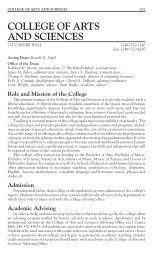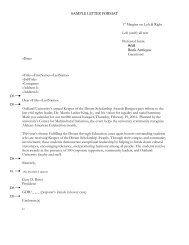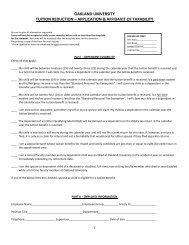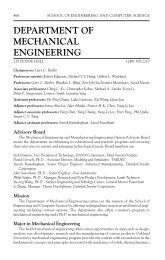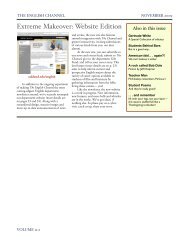MOM 2006 journal for pdf.pmd - University of Michigan-Flint
MOM 2006 journal for pdf.pmd - University of Michigan-Flint
MOM 2006 journal for pdf.pmd - University of Michigan-Flint
Create successful ePaper yourself
Turn your PDF publications into a flip-book with our unique Google optimized e-Paper software.
1T 3T 5T<br />
Figure 1: The cluster models (X = H or OH)<br />
10T<br />
Results<br />
There are five possible ways <strong>for</strong> NO 2<br />
to adsorb on Cu-ZSM-5 (Figure 2). The first possibility is <strong>for</strong><br />
nitrogen to bind to copper (A). Another possibility is <strong>for</strong> one <strong>of</strong> the oxygen atoms to bind to copper (B<br />
and C). In the B structure the second nitrogen is in line with the Cu-O bond, while in the C structure<br />
the second oxygen is located 90ˆ from the Cu-O bond. Another possibility is <strong>for</strong> both one <strong>of</strong> the<br />
oxygen atoms and the nitrogen to bond to copper <strong>for</strong>ming a Cu-O-N ring (D). Finally the last<br />
possibility is <strong>for</strong> both <strong>of</strong> the oxygen atoms to bind to copper, thus <strong>for</strong>ming a Cu-O-N-O ring (E).<br />
Since NO 2<br />
is a polar molecule and the dipole moment points to N from O, different binding types<br />
should affect the bonding in NO 2<br />
and the relative stabilities <strong>of</strong> the different adsorption complexes.<br />
The HF method was used to obtain an initial optimization <strong>of</strong> the geometry and orbitals <strong>for</strong> each<br />
adsorption complex. To include the correlation effects, optimizations at the DFT level were then<br />
per<strong>for</strong>med using the HF results as a starting point. The optimized DFT geometries are listed in Table 1<br />
and the relative energies are listed in Table 2.<br />
Although there are five possible structures, only 2 or 3 (depending on the cluster size) are stable<br />
adsorption complexes, ie. they represent local minima on the potential energy surface. The DFT<br />
results indicate that the E structure is the most stable adsorption complex regardless <strong>of</strong> the cluster size.<br />
The A, B, and D structures occur as local minima, though never all three with the same cluster. The C<br />
structure, however, never occurs as a local minimum. This is because the lone pairs <strong>of</strong> electrons on<br />
oxygen in this structure are in orbitals, whose orientation is not favorable <strong>for</strong> this complex. If the C<br />
structure were to exist, there would be a large strain on the Cu-O bond. If this strain were relieved by<br />
the reduction <strong>of</strong> the Cu-O-N bond angle, then the other oxygen in NO 2<br />
would nearly overlap with an<br />
oxygen atom in the zeolite. Both <strong>of</strong> these situations are energetically unfavorable. Thus the C<br />
structure cannot be a stable complex.<br />
Meeting <strong>of</strong> Minds <strong>2006</strong> 71



